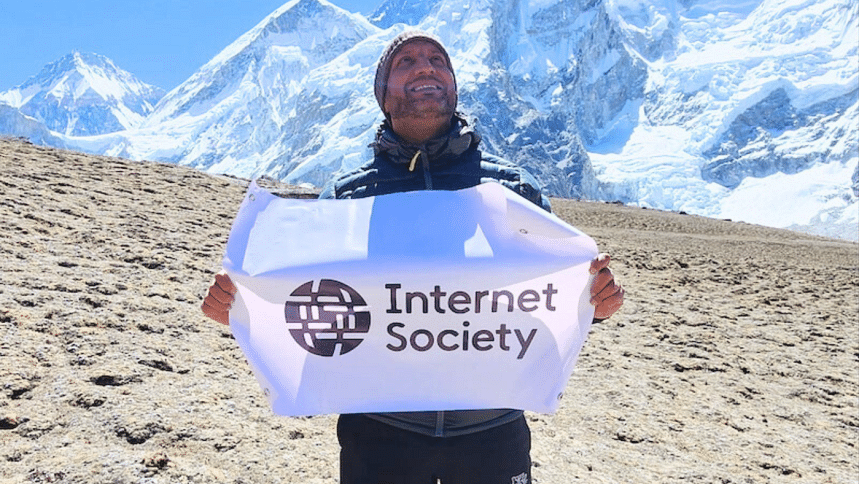Internet by the people, for the people: Naveed Haq on digital inclusion

Naveed Haq, Senior Director of Infrastructure and Connectivity at the Internet Society (ISOC), has dedicated his career to bridging the digital divide—especially in Asia-Pacific. From the mountainous trails of Nepal to the remote villages of Papua New Guinea, Haq's work exemplifies how inclusive and community-led innovation can transform lives. In an exclusive interview, he discusses ISOC's vision, the role of grassroots networks, and the future of digital inclusion.
Q: You've worked extensively across Asia-Pacific to improve infrastructure and connectivity. What have been some of the most rewarding or challenging experiences?
Naveed Haq: Establishing internet connectivity in remote or marginalised regions always demands passion, creativity, and community engagement. The most challenging projects are often the most fulfilling.
Three projects stand out. First, the Everest Community Network in Nepal. In partnership with the Nepal Internet Foundation and the Sherpa community, we built the world's highest community network in Khunde and Khumjung—villages just over 10km from Everest Base Camp. More than 1,500 Sherpas now have access to fibre internet, transforming opportunities in education, health and communication.
Second, the Maldives Internet Exchange Point (MVIX). This began as a casual discussion between local ISPs and organisations like ISOC and APNIC. We supported training, planning and deployment to launch the country's first IXP, helping improve internet resilience and performance across this small island state.
Third, the Gabaspot Community Wi-Fi in Papua New Guinea. Gabagaba village previously had little to no access. With regulatory support and local leadership, we helped launch a community-run network that now connects around 5,000 people. Digital literacy, remote education, and job access have all improved. The project shows what's possible when policy and community align.
Q: As senior director of infrastructure and connectivity, what are your current focus areas?
Haq: Our 2030 Strategy is grounded in the belief that the internet should enrich people's lives and be a force for good. My priorities focus on expanding affordable, reliable and resilient access.
We're concentrating our IXP efforts on Least Developed Countries (LDCs) and Small Island Developing States (SIDS). On the community connectivity front, we are focusing on indigenous peoples, displaced populations, and women-led social enterprises.
Q: How do you measure the real-world impact of infrastructure projects aimed at connecting the unconnected?
Haq: We use both qualitative and quantitative measures. But often, the most powerful indicators are the stories from the communities themselves. These stories show how local connectivity solutions can close digital gaps and transform lives—what we call "internet by the people, for the people."
Q: What emerging technologies do you see as key to bridging the digital divide over the next decade?
Haq: Advances in spectrum management—like TV white spaces and Wi-Fi 6—can greatly benefit underserved areas. Additionally, low-Earth orbit satellite networks are showing promise in offering affordable, resilient access to remote communities.
Q: How do policy and regulation support or hinder connectivity efforts in developing regions?
Haq: Many unconnected communities remain offline due to policy and market failures. Policymakers have a crucial role in fostering inclusive, enabling environments.
Traditional networks won't reach everyone. We need frameworks that allow diverse models to flourish—especially community-led ones. Imagine small villages receiving seed funding, training and support to launch their own networks. These communities can build sustainable businesses, keep costs low, and serve their neighbours—something large telecoms won't do.
We work with policymakers to help shape such inclusive strategies. It's not a technical issue—it's about vision and will.
Q: You've collaborated with many different communities and cultures. What strategies help foster inclusive partnerships?
Haq: Listening is key. Understanding each community's needs, culture, and context helps build trust and create solutions that stick. Success comes from community ownership, not external control.
There is no universal model. What works in Papua New Guinea may not work in Nepal. Our role is to facilitate, not dictate.
Q: What does a truly open internet mean to you in practice?
Haq: A truly open internet allows people to connect, create, and communicate freely. But that openness is under threat—from both state and corporate actions that risk fragmenting the internet.
We advocate for an internet that remains global, secure and interoperable. Otherwise, we risk a future where the internet is no longer the shared, empowering space it is today.
Q: What role do local communities and grassroots organisations play in shaping digital inclusion efforts?
Haq: They are absolutely central. In many of our projects, grassroots organisations take the lead. For example, in Africa, some community network initiatives—like Aheri—have evolved into respected brands.
With the right policy environment, these organisations can build and manage networks that are locally relevant, sustainable, and impactful.
Q: What inspired your journey into internet infrastructure and policy?
Haq: I grew up in a rural Pakistani village without any internet access. In the late 1990s, during university, my father bought me a computer. We used a $4 prepaid internet card that connected at 40 kilobits per second. It took minutes to load a Yahoo page—but that experience changed my life.
I started my career at the Pakistan Telecommunication Authority, working on policy and regulation. In 2013, I joined the Internet Society. It has allowed me to merge community work with infrastructure and policy—something I'm deeply passionate about.
Q: How does ISOC support its members in building technological and policy capacity?
Haq: Our members and chapters are the driving force of ISOC. They take courses, host events, advocate for change, and connect with a global network of peers. We equip them with the tools and knowledge to lead efforts in their own communities.

 For all latest news, follow The Daily Star's Google News channel.
For all latest news, follow The Daily Star's Google News channel. 








Comments